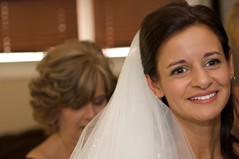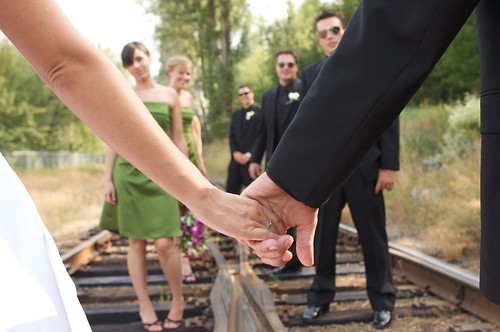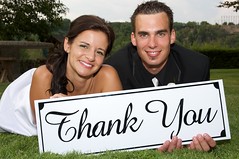My partner and I were in Rossland, BC, heading to the wedding when my cell phone beeped alerting me to a new voice message. I picked up the message. It was my sister. The message went something like this - "Amie's mom just called and she wants to know if you brought your camera equipment. The photographer is missing". WOW! Two hours before the wedding and they can't find the photographer who was booked one year in advance. Nice, easy, relaxing wedding day, snapping a few casual pictures from the background. Gone. It's go time! I called my sister back and let her know I had most of what I needed - my 40D, a few flashes and three lenses ( 17-40mm f/4.0L, 24-70mm f/2.8L and 70-200mm f/2.8L). We dash to the grocery store for AA batteries for the flashes and call the bride's father to tell him I was on my way.
I arrive at the bride's parents house in 20 minutes. 30 minutes later I'm taking pictures. The bad: zero time to plan. The good: zero time to get nervous.
My first wedding was a mix of flash and natural light and my flash results were mixed. I had been playing with my 580EX IIs for sometime so I felt confident I could get good results from Canon's ETTL system. Given the limited lighting equipment I was packing I decided to go with the 580EX II on the camera and a Sto-Fen omnibounce on top. Set the flash to ETTL and you're good to go! I remember reading in a book from Rick Sammon that a good place to start with ETTL flash was underexpose by about a stop and up the flash exposure compensation by about a stop. Those settings are simple to manage and gave good results.

Good idea going with ETTL but I quickly discovered an obstacle. The maximum flash sync speed on my 40D is 1/250th of a second. Outdoors on a bright sunny day, even in the shade (where I took a lot of my shots), it's tough to stay at or under 1/250th, especially when shooting at larger apertures, which is what I what for those beautifully blurred backgrounds. One solution is to block light with a polarizer or a neutral density filter. I had the former, not the latter. The polarizer is good because it reduces reflections, saturates colours and it blocks about 1 to 1.5 stops of light. I slapped it on but it was still not quite enough. A 3-stop ND filter would have been better. I also remember hearing David Ziser talk about going above the max sync speed on Kelbytraining. You could probably push the shutter up to 1/320th or 1/400th and still get the top half of the subject lit with flash. Of course, this does not work if flash is the only source lighting your subject. In that case you would get the black bar across the bottom half of the image. There is a good explanation for it here. The 580EX II also has a high-speed sync setting, which I have never tried before and honestly I forgot about it during the shoot. I also didn't remember the David Ziser tip until I started writing this blog - see it's working.
Keeping within 1/250th of a second I'm stopping down to f/8. My backgrounds are much too sharp for my liking as shown in the shot below. It's an OK shot but it could have been better.

Overall I was pretty happy with the results. I made a lot of great pictures, the exposures were good and I don't think I've ever shot so many sharp pictures in one go since I started shooting! However, there is always room for improvement so here are my tips for myself for next time.
1. I didn't have the luxury to scope out good backgrounds and locations ahead of time but there is always time to look for a better place to take good shots. If you can't do it send someone else - your partner, friend, father of the bride, the family dog... whatever. Better location equals better photographs.
2. Slow down, take your time. For those once-in-a-lifetime moments you may have to grab shots on the fly but when it comes to the posed part, take... your... time. It would be better to get a half dozen amazing shots rather than twenty or more so-so ones.
3. When the action is moving make sure your focus is too. AI servo is the mode on Canon cameras.
4. When posing groups always tell them "if you can't see the camera, the camera can't see you".
5. A friend of mine gave me a great tip. He said he loads a few photos on his iPod (or whatever) of other wedding photographers he really likes and references those photos while shooting for inspiration and ideas.
6. Use a tripod. Great for making/directing complex compositions. You worry about getting people in the right places and you don't have to worry about the camera position moving. And, it forces you to slow down and really think about your compositions.
7. Finally, there is always time to try something a bit out of your norm, so do it. You never know what you may come up with.
My favourite shot from the wedding.

More of the wedding shots can be seen here.



No comments:
Post a Comment